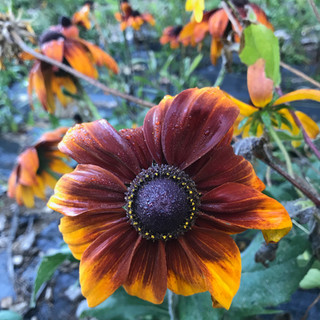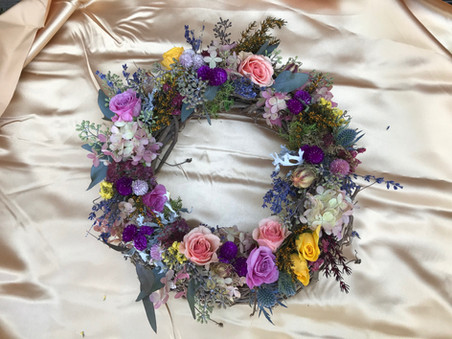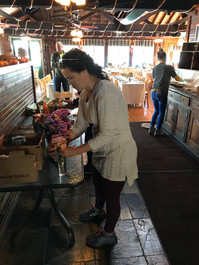Native Farm Flowers in Upstate New York
- Chris and Leah

- Nov 8, 2019
- 8 min read
Updated: Oct 8, 2023

After a great time in the UK, it was time to return to the U.S. We picked up our dog, Juniper, from her very generous surrogate family near Hudson, NY and continued on. Thanks so much to Rebecca, Steven, Svea, and Kiddi! It was just a short ride up the Hudson to Saratoga Springs, NY to work with our next host farm. For us, finding farm hosts (especially livestock farms) that are willing to accommodate a dog has been difficult. This time we were very lucky, Barbara's dog Meadow is the same age as Juniper and was an energetic, well-behaved dog friend!
The Farm
Native Farm Flowers, located just north of Saratoga Springs in Greenfield Center, is owned and managed by our host Barbara. She has been a farmer-florist since the mid 80s. The location of the farm has moved during that time, but is now settled on land that is part of a farmland trust in a "Right-To-Farm" community. Being support by the Right-To-Farm laws in New York State means that "when non-agricultural development extends into farm areas, competition for limited land resources results. Ordinances inhibiting farming tend to follow, farm taxes rise, and hopes for speculative gains discourage investments in farm improvements, often leading to the idling or conversion of potentially productive agricultural land." To sum it up, her farm land will remain as farm land into the future; it cannot be subdivided or developed further. Her parcel of around 10 acres was part of a much larger property that now supports other neighboring small farms. As a farmer-florist, the business grows flowers, but also does arrangements for weddings and events.
Early on, Barbara tried vegetable farming, but after some disappointing farmer's markets resulted in boxes of labor-intensive vegetables that couldn't be sold, she decided to make a change. She found flowers to be more profitable, less back-breaking, and 35 years later we were able to benefit from her experience. She is doing almost all the labor on her own. During the busiest months of the season, she has one part-time employee working 8-12 hours per week, as well as a good friend who helps each Saturday at the farmers market.
The rules and regulations that affect farmers in the U.S. vary from state to state. New York state is known for high taxes, universal Pre-K, and paid parental leave, but also has an amazing program for farmers called FarmNet. The NY Department of Agriculture funds this program with the goals of keeping farmers in business through attending to their financial and mental well-being. FarmNet offers support services like counseling, business consulting, and financial analysis for free to farmers. We were fortunate to be present for one meeting while we were on the farm. That's right, the service providers come to the farm, encouraging busy farmers to actually take part.
Local support for small farms doesn't end there. During our first week on the farm we were lucky to attend a fundraiser called Feast of the Fields hosted by Saratoga PLAN (Preserving Land and Nature). It is the land conservation non-profit that was instrumental in helping Barbara secure her current farm site. Saratoga Springs has a rich history of horse racing and mineral waters that has brought visitors from New York, Boston, Montreal and beyond to the area since the 18th century. Barbara donated table arrangements for the event, and in exchange we got to hang out at a very fancy country club for the night. Besides the usual calls for donations, live and silent auctions, etc., the focus was on food. Chefs from 12 local restaurants and 17 drink providers (cideries, distilleries, wineries, breweries) provided food and beverages, mostly direct from area small farms, to show off the amazing things that can be produced on the land when it is saved from development.
The Flowers
As a flower farmer, Barbara seeks to grow a huge diversity of flowers and greenery throughout the year. However, part of the farm florist job also involves ordering from wholesale florist supply companies for items that aren't grown on site or are not available seasonally from the farm. The variety of flowers and greenery available at the farm, even into the fall, was impressive. It reminded me of a vegetable farm that has 50 crops and 100 different varieties. So many different perennials, biennials, and annual plants; some trees, some in beds in the field, some in greenhouses, some being grown just in pots or bulb crates; all to offer customers a wide selection no matter the time of year. Just like with vegetables, different varieties of a single flower species were selected for different flowering times, to extend their availability, while still only having to seed or transplant once.
We were there during the seasonal transition from summer crops to fall crops. Late season flowers were still showing off, but it was also time to pick others and dry them for holiday and winter sales. In the Saratoga Springs area, the competition among flower growers is high. There were at least 8 farms at the farmers market selling flowers. In a competitive environment like this, finding an edge is important. Barbara has been setting herself apart from the others through a unique selection of plants not found in the Johnny's catalog, as well as by growing using organic methods (though not certified). She also offers beautifully crafted wreaths, swags, dried arrangements and scarves & ties dyed with plant materials.
The Market
Native Farm Flowers sells at a large, lively farmer's market in Troy, NY which runs year round (indoors Nov - March). Since the farmer's market is 'producer only', all the plants in the farm bouquets must be grown at the farm. That allows Barbara to know week by week (with some variation) what will be available and plan accordingly. In addition to selling fresh and fresh-to-dry bouquets, the market stand also offers custom made bouquets, arranged and wrapped to order, for customers who wish to have more specific arrangements. Growing and preparing for both Saturday market and Saturday wedding(s) is especially demanding and sometimes complicated.
In 2019, Barbara had 26+ weddings, and sometimes up to 3 weddings/events in the same weekend! Luckily some customers preferred to pick-up their order right at the farm, so not having to deliver is a big help. In the summer, preparing for weddings and preparing for market overlapped every week, with Saturday also being the most popular wedding day. This meant picking and arranging everything needed for market, PLUS picking/ordering flowers for bridal bouquets, table centerpieces and so much more. Weddings are totally dependent on the desires of the bride, or the bride's mother. That means not only ordering from wholesalers as needed, but also trying to take an idea from the bride, or a few photos, and come up with a color scheme and a set of arrangements that will be beautiful in the way the bride wants on the big day. So much of it comes down to an artistic eye and creativity in the moment, both of which Barbara has mastered.
The Production
Constant attention is required to all stages of growth on the flower farm. While we were there, late in the season, it was time to transplant biennials into the hoophouses, prune perennials, and pick the remaining dahlias, zinnias, marigolds, strawflowers, and celosia. After picking, flowers were brought to the covered work area. The next step was stripping, removing most of the leaves for a long, smooth stem, and then putting the flowers into buckets with water and storing in a walk-in cooler.
When it was time to create bouquets, the flowers and greens were organized by type on the table. Next, Barbara would demonstrate the size and combination of flowers and greens that should go into a bouquet. From there, we were able to try out our own ideas and variations on the theme. The calculation of how many arrangements to bring to the market was based on sales from previous weeks, the weather report (sunny days = more sales), and the variety of flowers currently available.
Having a wide variety of plants across as wide a season as possible is so important in the flower business. You have to be equally ready for the onslaught of flower purchases for Mother's Day in early May as for Christmas in December. Covered space on the farm makes a big difference in being able to do this. The farm currently has one heated greenhouse, one hoophouse, and is waiting on the installation of one more. Part of our work was to clear land for the new hoophouse. We moved perennial bushes into new beds, removed old drip tape and landscape fabric, and tilled up new ground. Then we added the farm's own compost and sowed cover crops to prepare the soil for planting next spring. Barbara received a reimbursement grant from USDA through NRCS (Natural Resource Conservation Service), that helps small farmers fund the installation of these structures.

The Weddings
Wedding preparations were a little more rigid and required closer scrutiny of our work. The usual wedding included a bridal bouquet, smaller bouquets for the bridesmaids, groom's boutonniere, mother's corsages, and centerpieces for all the tables at the reception. Some add-ons we helped with for weddings included groomsmen boutonnieres, flower tiaras, strings of flowers, decorated hoops, flower wands, attaching swags to ceremony arbors, putting table arrangements and greenery on tables, rigging a table bouquet holder, and filling flower petal bags. We were also part of intense preparations for a Hindu wedding ceremony which included a massive 14' X 1' flower cover for the mandap, the structure where the actual wedding ceremony takes place. For all the weddings that we helped with, it was rewarding and fun to see everything come together on the big day after working in the fields and arranging everything back at the farm during the days leading up to it.
Being a farm florist for weddings brings in the most income compared to other markets. It also requires a lot of work, which we learned from observing and helping Barbara each day for just a short month. Usually, initial conversations about wedding bookings happen a year in advance. While this may seem excessive, it is actually helpful, as it allows Barbara time to grow flowers specifically for the wedding if need be. For example, the mandap cover and flower strings for the Hindu wedding required lots of marigolds, more than she would usually grow for the whole season, so two additional beds were planted so they would be available in the fall. She might also try growing a species that she hasn't grown before if there is interest from the brides. We really admired Barbara's ability to create beautiful wedding arrangements from start to finish-from planting the seeds or transplanting the bulbs to arranging bouquets according to theme and color, all the way to delivery. It's no easy task and Barbara's creativity and tenacity to continue growing new varietals and creating fresh ideas each year for the past 30 years was admirable.
The Rest
While we really enjoyed our time with Barbara- sharing meals together (especially pizza!), talking about politics, hanging with the dogs, and relaxing on the screened-in porch- we still managed to explore the Adirondacks area, Quebec and elsewhere in New England. We went on lots of hikes in the beautiful fall colors with Juniper and visited some friends in New Hampshire and Vermont (thanks Andy and Amie & Sam!). We had our first maple creemee (unbelievable) and learned that Juniper's favorite past time is chilling out in New England creeks. Of course, we were able to indulge in some tasty food and wine all over, especially in Montreal where the bagels were definitely memorable. We also checked out Quebec City just to feel like we were in Europe again and discovered a pretty sweet black currant farm where we got to try various kinds of currant gelato. We will definitely miss our time in New England (and Juniper will miss her two New Yorker friends dearly too, Meadow and Kiddi)!
More to come soon from a Virginia grass farm!


























































































































































































































Comments